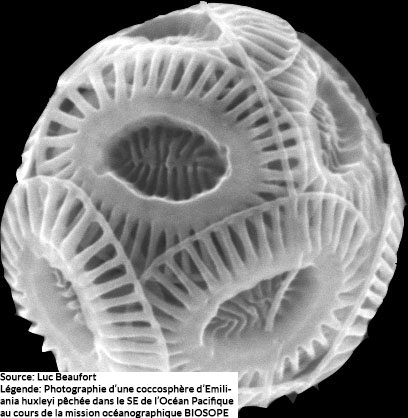CHIli – COccolithes: The Regime of Westerlies and Oceanic Fronts in the South Pacific Ocean since the Last Glacial Maximum
Funding
INSU-LEFE-IMAGO 2013 (2013-2016)
Project leader
S. Duchamp-Alphonse (GEOPS)
Collaborations
L. Beaufort (CEREGE), G. Siani (GEOPS), E. Michel (LSCE), N. Durand (LMC14), et C. Kissel (LSCE).
Measurements of CO2 trapped in Antarctic ice reveal that the pCO2 of the atmosphere during the Last Glacial Maximum (LGM) was 80 to 110 ppmv lower than the pCO2 value recorded for the interglacial period, before any anthropic activity. It turns out that significant changes in the position and intensity of oceanic fronts and of winds from the west (westerlies) in the high latitudes of the Southern Hemisphere, could on their own explain these major changes in atmospheric pCO2 by impacting on (i) the physical pump (ventilation of intermediate and deep ocean water masses); (ii) the effectiveness of the biological pump (variations in primary production); and (iii) ice coverage. In other words, these three mechanisms impact significantly on the amplitude of CO2 exchanges between the ocean reservoir and the atmospheric reservoir. The objective of this project is to better define the impact of the ocean-atmosphere system of the southern high latitudes on global levels of pCO2 in the Last Glaciation by simultaneously considering the physical and biological pumps. In particular, it aims to tackle the following issues: (i) the impact of the regime of westerly winds and oceanic fronts on the ventilation of intermediate and deep ocean water masses in the South Pacific Ocean (water stratification v upwelling); and (ii) the effectiveness of the biological pump (variations in primary production) since the LGM through the study of coccolithic assemblages (calcareous phytoplankton) and measurement of COT and CaCO3 contents of three sedimentary cores taken from Sub Antarctic zone of the Pacific sector. Through a thesis being prepared by Elisabeth Teca (2019-2022), this project is completed by the study of diatom assemblages (siliceous phytoplankton) from sedimentary cores MD07-3088 and MD07-3082.
 Figure : Map showing the geographical locations of cores studied in this project (MD07-3100, MD07-3088 and MD07-3082); the cores follow a latitudinal transect within the sub Antarctic zone of the Pacific sector and are likely to record the dynamic of oceanic fronts in the region since the Last Glacial Maximum.
Figure : Map showing the geographical locations of cores studied in this project (MD07-3100, MD07-3088 and MD07-3082); the cores follow a latitudinal transect within the sub Antarctic zone of the Pacific sector and are likely to record the dynamic of oceanic fronts in the region since the Last Glacial Maximum.

